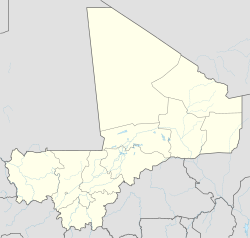Bafoulabé
| Bafoulabé | ||
|---|---|---|
|
|
||
| Coordinates | 13 ° 48 ′ N , 10 ° 50 ′ W | |
| Basic data | ||
| Country | Mali | |
| Kayes | ||
| circle | Bafoulabé | |
| ISO 3166-2 | ML-1 | |
Bafoulabé is a city in southwest Mali , in the Kayes region . It is the capital of the Bafoulabé district , which was the first cercle in Mali in 1887 .
Administrative structure
Until 1996 Bafoulabé was the capital of an arrondissement . After a regional reform, the place is the seat of a "rural community" made up of 28 villages and at the same time the administrative seat of the Bafoulabé district.
Geography and climate
At Bafoulabé the Bafing and Bakoy flow together to form the Senegal River . In Bambara , Bafoulabé means “meeting of the two rivers”. About 90 km southeast of Bafoulabé is the Manantalidamm on Bafing . The dam and its reservoir, Lake Manantali , are each the largest dam and lake in Mali.
Stretching over the shores of Senegal, Bafoulabé is bounded to the north by the municipalities of Tomora and Sidibéla , to the east by Kontéla and Oualia , to the south by Mahina and to the west by Diamou . The climate is Sahelian . The rainy season from June to October brings less than 900 mm / m² of precipitation per year. During the dry season there is a hot phase from February to June and a cooler phase from November to February. The maximum temperature can reach 41 ° C in the shade.
Population and culture
In 1998 Bafoulabé had a population of 16,670 and according to the 2009 census it has 19,955 inhabitants. During the colonial period, Bafoulabé was a thriving commercial center as a result of the construction of the Dakar-Bamako Railway in the early 20th century. The city is mainly inhabited by Khassonké , Malinke , Soninke and Fulbe . A well-known former citizen of the city is Fily Dabo Sissoko , one of the founding fathers of Mali.
Town twinning
Individual evidence
- ↑ INSTAT: Results of the 2009 census ( Memento from July 22, 2011 in the Internet Archive ) (PDF; 860 kB)
- ↑ Conversation with Sekou Diawara

